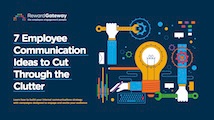
4 min read
It’s exciting to launch a new program. One that you know will delight and engage your employees — you’ve done your homework, you’ve got the leadership team on board and now you’re sitting in a room with the team wondering what you’ve gotten yourself into.
Then, it settles in. That moment of panic:
How are we ever going to pull this off?
When it comes to launching a new initiative, we’re often so caught up by the logistics of how the operations will actually work we don’t think too much further ahead about how we’re going to get people to really engage with it.
And why would we?
Often the product is the result of evidence from your people that shows this is something they want, so surely the trusty email blast should be enough… right?
I can tell you from experience, it’s not that easy.
To “go into battle,” you need to equip yourself with:
- Why you’re trying to reach your audience
- Who your audience is
- What you’ll reach them with

First up, the “why": Your employee communication objectives
Before I start any communications plan I always begin by listing my objectives — what do I really want to achieve with this plan? What do I want people to do with this information? These are the bedrocks of your employee communications planning.
Objectives could be related to the message you want to convey, but they can also relate to how you want people to feel or what you want them to do.
Wherever possible I build my objectives around measurable results so right from the very start I have at least a rough plan of how I’m going to know if the communications have been successful. After I set the objectives these become the bedrocks of my campaign which I refer back to constantly, and never more importantly than when I’m creating the messaging.
After writing your content take a step back and measure it against your objectives to see how it’s going to get you to your goals. Does it fit the whole profile, or do you need to make any tweaks?

Next, the "Who": Your employee audience
Defining your audience — your employees — is so incredibly important. A couple questions I like to ask our clients:
- Are most of your staff over forty or fresh out of university?
- Is it mostly people at a desk or employees in the field?
- Are you aiming to be formal, casual, exciting, classic or something completely different?
For example if you wanted to go for a more corporate brand the design elements you would use would be more elegant, simple, and more straight to the point. If you wanted to develop something more fun and exciting you would lean more towards elements that include curving lines and lots of color. It’s important to decide what direction you want to go in and commit to those ideas.

Your target audience will define your “what.”
No matter what organization you work in, you will have different groups of employees who prefer different types of communication and it’s important you make it easy for them to access the information so they don't cast it aside. I’ve used an expression many times over the years at RG which sums this up nicely:
Go where the eyes are.
Are your employees tech-savvy, or do they hate email? Is an in-person connection better for them to learn, or would they rather printed materials to review on their own time?
Don’t make your people work to find things out, and ensure you’re putting content in the places they’re already looking. In the case of a new program launch this might mean following up your email with an article on the company blog (hello!), adding it to your other social media channels like Snapchat, Twitter or Facebook, or even sending a letter to the home address of really hard-to-reach employees.
To reduce cost and time affiliated with the repetition of these tasks, make sure you’re collecting data points on opens and engagement rates so that you know what avenue reaches the most employees.
You don’t have to use every tool in your arsenal, but putting your message out via three key channels is a good rule to live by.
Check out my other posts for more tips on how to master employee communications. Working with clients has taught me many tips over the years as we continue to learn from each other, launch after launch (after launch ... after launch ...).
Share your best advice with me in the comments!
Plus, don't miss out on more advice on how to get the most of your employee communications with some of my favorite examples in this eBook:

 Megan Wiseman
Megan Wiseman

